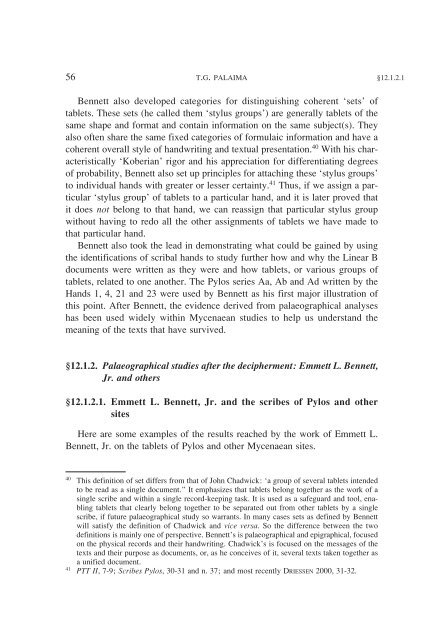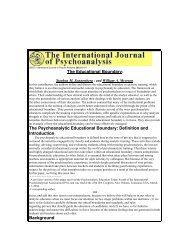A Companion to Linear B - The University of Texas at Austin
A Companion to Linear B - The University of Texas at Austin
A Companion to Linear B - The University of Texas at Austin
Create successful ePaper yourself
Turn your PDF publications into a flip-book with our unique Google optimized e-Paper software.
56 T.G. PALAIMA §12.1.2.1<br />
Bennett also developed c<strong>at</strong>egories for distinguishing coherent ‘sets’ <strong>of</strong><br />
tablets. <strong>The</strong>se sets (he called them ‘stylus groups’) are generally tablets <strong>of</strong> the<br />
same shape and form<strong>at</strong> and contain inform<strong>at</strong>ion on the same subject(s). <strong>The</strong>y<br />
also <strong>of</strong>ten share the same fixed c<strong>at</strong>egories <strong>of</strong> formulaic inform<strong>at</strong>ion and have a<br />
coherent overall style <strong>of</strong> handwriting and textual present<strong>at</strong>ion. 40 With his characteristically<br />
‘Koberian’ rigor and his appreci<strong>at</strong>ion for differenti<strong>at</strong>ing degrees<br />
<strong>of</strong> probability, Bennett also set up principles for <strong>at</strong>taching these ‘stylus groups’<br />
<strong>to</strong> individual hands with gre<strong>at</strong>er or lesser certainty. 41 Thus, if we assign a particular<br />
‘stylus group’ <strong>of</strong> tablets <strong>to</strong> a particular hand, and it is l<strong>at</strong>er proved th<strong>at</strong><br />
it does not belong <strong>to</strong> th<strong>at</strong> hand, we can reassign th<strong>at</strong> particular stylus group<br />
without having <strong>to</strong> redo all the other assignments <strong>of</strong> tablets we have made <strong>to</strong><br />
th<strong>at</strong> particular hand.<br />
Bennett also <strong>to</strong>ok the lead in demonstr<strong>at</strong>ing wh<strong>at</strong> could be gained by using<br />
the identific<strong>at</strong>ions <strong>of</strong> scribal hands <strong>to</strong> study further how and why the <strong>Linear</strong> B<br />
documents were written as they were and how tablets, or various groups <strong>of</strong><br />
tablets, rel<strong>at</strong>ed <strong>to</strong> one another. <strong>The</strong> Pylos series Aa, Ab and Ad written by the<br />
Hands 1, 4, 21 and 23 were used by Bennett as his first major illustr<strong>at</strong>ion <strong>of</strong><br />
this point. After Bennett, the evidence derived from palaeographical analyses<br />
has been used widely within Mycenaean studies <strong>to</strong> help us understand the<br />
meaning <strong>of</strong> the texts th<strong>at</strong> have survived.<br />
§12.1.2. Palaeographical studies after the decipherment: Emmett L. Bennett,<br />
Jr. and others<br />
§12.1.2.1. Emmett L. Bennett, Jr. and the scribes <strong>of</strong> Pylos and other<br />
sites<br />
Here are some examples <strong>of</strong> the results reached by the work <strong>of</strong> Emmett L.<br />
Bennett, Jr. on the tablets <strong>of</strong> Pylos and other Mycenaean sites.<br />
40 This definition <strong>of</strong> set differs from th<strong>at</strong> <strong>of</strong> John Chadwick: ‘a group <strong>of</strong> several tablets intended<br />
<strong>to</strong> be read as a single document.” It emphasizes th<strong>at</strong> tablets belong <strong>to</strong>gether as the work <strong>of</strong> a<br />
single scribe and within a single record-keeping task. It is used as a safeguard and <strong>to</strong>ol, enabling<br />
tablets th<strong>at</strong> clearly belong <strong>to</strong>gether <strong>to</strong> be separ<strong>at</strong>ed out from other tablets by a single<br />
scribe, if future palaeographical study so warrants. In many cases sets as defined by Bennett<br />
will s<strong>at</strong>isfy the definition <strong>of</strong> Chadwick and vice versa. So the difference between the two<br />
definitions is mainly one <strong>of</strong> perspective. Bennett’s is palaeographical and epigraphical, focused<br />
on the physical records and their handwriting. Chadwick’s is focused on the messages <strong>of</strong> the<br />
texts and their purpose as documents, or, as he conceives <strong>of</strong> it, several texts taken <strong>to</strong>gether as<br />
a unified document.<br />
41 PTT II, 7-9; Scribes Pylos, 30-31 and n. 37; and most recently DRIESSEN 2000, 31-32.

















